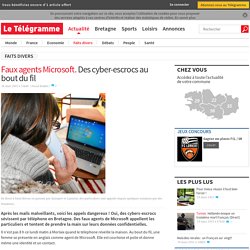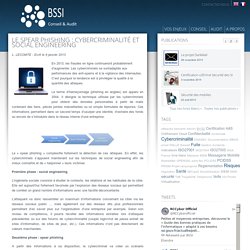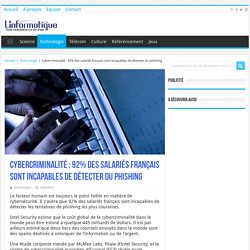

Les faux profils prolifèrent sur les réseaux sociaux. Qu'ils émanent de robots ou qu'ils soient créés pour usurper l'identité d'un people, les faux profils sont en constante augmentation sur internet.

Twitter et Facebook tentent de protéger leurs utilisateurs. En 2013, 61,5% du trafic sur internet est généré par des robots, révèle le site du communicant. Seul 38,5% est donc dû à des humains. Soit une augmentation de 21,5% entre 2012 et 2013. Les réseaux sociaux doivent, eux aussi, faire face à la hausse de faux profils. Sur les réseaux sociaux , les faux profils peuvent être générés par des machines ou être le fruit d'une usurpation d'identité. In a Digital World of Phishing, Hacks, & Counterfeiting, New Dot Brands Offer More Security & Trust. Jennifer Wolfe | March 25, 2015 | 0 Comments inShare22 Dot Brands can give a sense of security to consumers who may be susceptible to phishing emails or scams from fake companies.

I recently received a phishing email that looked like it was from American Express (see image below). There was the famous AmEx logo and the subject was alarming: "Unusual Activity in Your American Express account. " I opened the email and a few warning signs became the red flags to know it was a phishing email. With recent hacks at Target, Home Depot, and Sony bringing the issue of consumer trust and security to the attention of chief executives (CEOs) and boards across the world, the topic of security is front and center at most organizations. The Dot Brand, or a generic top-level domain that is closed for exclusive use by a brand, creates a unique and new opportunity to build a safer community of the Internet and offer consumers more security and trust.
Le facteur humain au service du cybercrime. Plusieurs études montrent que 92% des salariés français se font piéger par des tentatives de hameçonnage.

Faux agents Microsoft. Des cyber-escrocs au bout du fil - Faits divers. Après les mails malveillants, voici les appels dangereux !

Oui, des cybers-escrocs sévissent par téléphone en Bretagne. Le spear phishing : cybercriminalité et social engineering. L.

Cybercriminalité : 92% des salariés français sont incapables de détecter du phishing. Le facteur humain est toujours le point faible en matière de cybersécurité.

From Hacking Systems To Hacking People. New low-tech attack methods like 'visual hacking' demand an information security environment that values data privacy and a self-policing culture.

Forty-four trillion gigabytes. That’s the anticipated size of the “digital universe” by 2020, according to the IDC Digital Universe Study. Encompassing all data created, replicated, and consumed in one year, this digital universe is largely created and used by a company’s workforce, but the task of protecting this enormous amount of data from hackers falls largely to IT security teams. Data security professionals have built up sophisticated defenses against hackers targeting company networks and systems through high-tech attacks. However, as we layer cryptography with firewalls, intrusion detection systems, and other defenses, hackers will need to identify a new access point to proprietary company information and I believe we’ll soon begin to see a profound shift from malicious parties hacking systems to hacking people. Zdnet. Fresh FireEye research suggests that today's cyberattackers are becoming smarter about the systems they seek to break, and are commonly using impersonation and social engineering to tap into the most common weakness in the security chain -- employees.

Within FireEye's sixth annual M-trends report, which tracks the threat landscape and emerging threat actors, the firm says that cybersecurity has now gone beyond the boardroom and has entered the mainstream thanks to the number of high-profile security breaches in 2014. When It Comes to Cybersecurity, Look Past Your Employees. Hardly a week goes by without media reports of a well-known business or agency having its data center hacked and sensitive information being stolen or damaged.

When news of these attacks breaks, the cybersecurity industry does a lot of hand wringing and pontificating over what is to be done about the increasing frequency and sophistication of today’s cyber attacks. Many security professionals are quick to blame the user. I’ve been in many a conference hall or closed-room meeting when the speaker, while sharing a story about how a user opened an email they shouldn’t have, turns to the audience and says with a knowing smile, “You can’t fix stupid.” This kind of thinking really chaps my hide. The Internet is an incredibly complex system of systems. The 7 Best Social Engineering Attacks Ever. Seven reminders of why technology alone isn't enough to keep you secure. 1 of 9 Image, via Wikipedia: Maquette Trojan Horse, used in the movie Troy, a gift from Brad Pitt to the Turkish town Çanakkale Social engineering is nothing new.

In 1849, Samuel Williams, the original "confidence man," as the newspapers named him, engineered gullible strangers out of their valuables simply by asking "Have you confidence in me to trust me with your watch until tomorrow? " Through the late 19th and early 20th century Joseph "Yellow Kid" Weil ran a variety of scams, including conning Benito Mussollini out of $2 million by selling him phony rights to mining lands in Colorado. 5 Social Engineering Attacks to Watch Out For. We have become all too familiar with the type of attacker who leverages their technical expertise to infiltrate protected computer systems and compromise sensitive data. We hear about this breed of hacker in the news all the time, and we are motivated to counter their exploits by investing in new technologies that will bolster our network defenses.
However, there is another type of attacker who can use their tactics to skirt our tools and solutions. Rp hacking human os. Des soldats américains pris pour cible par des hackeurs de l'Etat islamique ? Cyber-sécurité : éviter la menace interne en surveillant les portes du royaume. Les techniques de persuasion utilisées par les cybercriminels. 92 % des employés français, 80 % à travers le monde, se sont déjà fait piéger par des menaces informatiques et notamment par des tentatives d’hameçonnage. DataSecurityBreach.fr vous alerte très souvent sur les techniques de persuasion utilisées par les pirates informatiques.
Social engineering the new norm for hackers, nation-states. February 19, 2015 McAfee's new 'Hacking the Human Operating System' whitepaper focuses on the use of social engineering to attack home and business users, and finds once again that people are the weakest link. Social engineering the new norm for hackers, nation-states.
Intel Security warns of six social engineering techniques targeting businesses. Cyber security training and policy management is imperative for businesses, according to the Hacking the Human OS report by Intel Security. There is growing concern about the effect of cyber crime on the global economy, which is currently estimated to be around $445bn. maxkabakov - Fotolia The report encourages businesses to address and educate employees on the “six levers of influence” being used in the digital world by hackers. According to the report endorsed by the European Cyber Crime Centre (EC3), all businesses and employees should be aware of the basic persuasion techniques commonly used by cyber criminals.
Github : la nouvelle porte involontaire pour pirates. Fraude aux présidents : premières arrestations. Le secret était un secret de polichinelle. Plusieurs pirates, adeptes de la fraude au président, évoluent à partir d’Israël. Le Social Engineering : quand le pirate ne compte que sur la ruse. Quel peut donc être le point commun entre un aquarium géant du Nord de la France, un pirate informatique Israélien, des commissariats Français, Nestlé, Coca-Cola ou encore 55% des entreprises Françaises ? A première vue, rien. Who Influences You? Who Influences You? Like it or not, we are all products of our environments and our life experiences. The people we choose to surround ourselves with, personally and professionally, have a huge impact.
My career in cybersecurity is a testament to that fact, and I am thankful to have had many influential peers and mentors along the way. My earliest cybersecurity influencer was Cliff Stoll, and his book The Cuckoo's Egg from the early 1990s. Shortly thereafter, Dan Farmer developed one of the first vulnerability scanners, called SATAN (Security Administrators Tool for Analyzing Networks), which got lots of press and encouraged people like me to start thinking about the security of networks.
The Trust Engineers. 5 WAYS TO PROTECT YOURSELF FROM SOCIAL ENGINEERING ~ Pixels Formation. Social engineering is the practice of breaking into systems by exploiting the vulnerabilities in people around the system rather than directly breaching the system. Méfiez vous même des livreurs de pizza .... Social Engineering, Cloud Security, and Pizza. When I was in college, I took a class on computer security and was lucky enough to have a professor who really took a deep dive into social engineering.
I found the subject fascinating which led me to read Kevin Mitnick’s amazing books on social engineering called “The Art of Deception” and “The Art of Intrusion,” both of which I highly recommend everyone in your company reads. Comment l'armée infiltre les réseaux sociaux djihadistes. Question de confiance. PME visées par un cheval de Troie bancaire. Toujours les mêmes ficelles.... De l’eau dans le gaz pour des PC de chez GDF Suez. Phemail.py: another social engineering tool.
Common Internal Vulnerabilities. There is a perception by many organisations that their internal network is a relatively safe haven from attackers. The thought is that well configured firewall rules and regular external penetration testing of internet connections provide adequate protection for the internal network. “We are safe inside the firewall and we trust our users, so we don’t need to worry so much about hardening, patching, access control and the rest” is an all too familiar view.
However, although the security of externally facing networks has improved, we have seen a rise in social engineering, client side attacks and physical intrusions into networks as a means of bypassing these external network controls. Recent high profile cases where criminals planted rogue equipment inside networks to steal money are likely to be just the tip of the iceberg. Physical Intrusion Social Engineering. Social engineering is a service that my team and I get involved in on a fairly frequent basis.
While for the most part this involves remotely trying to convince targets to click on links in emails, browse to fake login pages, download carefully constructed files which lead to remotely accessible shells, or politely asking them for their passwords over the phone (all of which have been successful on multiple occasions), physically obtaining access to a client's site is one of the activities that I most look forward to. There are a number of useful gadgets available to gain physical access to client's offices, including devices such as the ubiquitous Proxmark, our own HumblePi ( and of course a small set of lockpicks.
Generally though, all that is needed is a notepad and pen, a cup of coffee, and a good cover story. Quand la femme fatale sur Skype piratait des rebelles syriens.
On devrait toujours se méfier d'un mail de travail qu'envoi un collègue un dimanche. Comment « Le Monde » a été piraté par l'Armée électronique syrienne. What is Social Engineering? - Security Through Education. Prévention et gestion des fuites d’informations. Social Engineering: How Dangerous is Your Lunch Break? Pro-ISIS Hackers Compromise U.S. CENTCOM Twitter, YouTube Accounts. The best digital security is analog: expert. The Most Cost-Effective Cyber-Security Initiative You Can Employ. The Ultimate Rorschach Test Designed To Dissect & Control. JPMorgan Hackers Targeted Weakest Security Link. Memorizing Strong Passwords - A retenir : "Operation Socialist" : la cyberguerre entre Européens. Cyber attack causes serious physical damage on a steel plant. Hackers: Experts in Their Field.